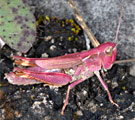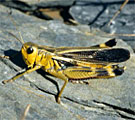Chorthippus apricarius (Linnaeus, 1758)
![Chorthippus apricarius: Male (Colle di Sampeyre, Italy, 2000m above sea level, August 2010) [N] Chorthippus apricarius: Male (Colle di Sampeyre, Italy, 2000m above sea level, August 2010) [N]](thumbs/acrididae/apricarius_m2011.jpg)
![Chorthippus apricarius: Female (Colle di Sampeyre, Italy, 2000m above sea level, August 2010) [N] Chorthippus apricarius: Female (Colle di Sampeyre, Italy, 2000m above sea level, August 2010) [N]](thumbs/acrididae/apricarius_w2010.jpg)
![Chorthippus apricarius: Male (Engadine) [N] Chorthippus apricarius: Male (Engadine) [N]](thumbs/acrididae/apricarius_m.jpg)
![Chorthippus apricarius: Male (Engadine) [N] Chorthippus apricarius: Male (Engadine) [N]](thumbs/acrididae/apricarius_m2.jpg)
![Chorthippus apricarius: Male, concealed behind a blade. The yellowish hind legs are visible. [N] Chorthippus apricarius: Male, concealed behind a blade. The yellowish hind legs are visible. [N]](thumbs/acrididae/apricarius_mhalm.jpg)
![Chorthippus apricarius: Pair on Urtica [N] Chorthippus apricarius: Pair on Urtica [N]](thumbs/acrididae/apricarius_m_w.jpg)
![Chorthippus apricarius: Female [N] Chorthippus apricarius: Female [N]](thumbs/acrididae/apricarius_w.jpg)
![Chorthippus apricarius: Female [N] Chorthippus apricarius: Female [N]](thumbs/acrididae/apricarius_w2.jpg)
![Chorthippus apricarius: Habitat in the Engadine [N] Chorthippus apricarius: Habitat in the Engadine [N]](thumbs/acrididae/apricarius_h.jpg)
![Chorthippus apricarius: Habitat on the Colle di Sampeyre (Italian Alps, Piemonte, 2000m above sea level, late August 2010) [N] Chorthippus apricarius: Habitat on the Colle di Sampeyre (Italian Alps, Piemonte, 2000m above sea level, late August 2010) [N]](thumbs/acrididae/apricarius_h2010.jpg)
Nutrition:
Grasses (Poaceae).
Habitat:
Chorthippus apricarius requires a juxtaposition of somewhat higher growing grasslands and at least small gappy areas with open soil. This can be realized in different locations. In Germany Chorthippus apricarius prefers border strips to extensive fields. In the Swiss Engadine, I met Chorthippus apricarius on grass- and herb-rich scarps with open soil and some shrubs between nutrient-poor meadows. In Southern Europe and the Southern Alps, Chorthippus apricarius can be found up to over 2000m above sea level on grassy and sometimes also stony slopes.
Life cycle:
The adults appear from late June to October, and the eggs are laid in open ground, such as old ant hills.
Endangerment: strongly endangered
Endangerment factors:
In Germany Chorthippus apricarius has strongly declined in many areas and is already extinct in most of the former habitats, for example in most parts of Baden-W�rttemberg. Chorthippus apricarius is still more common only in a few regions as in northeast Germany and the Swiss Grisons. The cause is the over-fertilization and intensive use of arable land as well as the eutrophication and eradication of all kinds of fallow strips.
In southern Europe the situation is still better.
Remarks:
Chorthippus apricarius occurs from the Pyrenees across Southern France, central and southeastern Europa to northern China. Isolated populations are reported from northwestern Spain, Central Italy and northern France.
Chorthippus albomarginatus | Chorthippus alticola | Chorthippus apicalis | Chorthippus biguttulus | Chorthippus binotatus | Chorthippus bornhalmi | Chorthippus brunneus | Chorthippus cialancensis | Chorthippus corsicus | Chorthippus dichrous | Chorthippus dorsatus | Chorthippus eisentrauti | Chorthippus jucundus | Chorthippus karelini | Chorthippus lacustris | Chorthippus mollis | Chorthippus montanus | Chorthippus nevadensis | Chorthippus oschei | Chorthippus parallelus | Chorthippus pulloides | Chorthippus pullus | Chorthippus reissingeri | Chorthippus rubratibialis | Chorthippus sampeyrensis | Chorthippus saulcyi | Chorthippus vagans | Chorthippus willemsei


